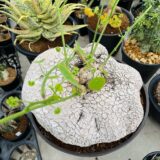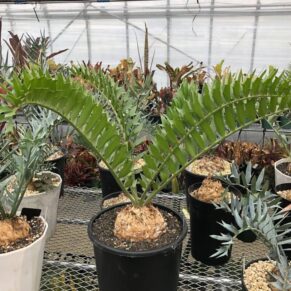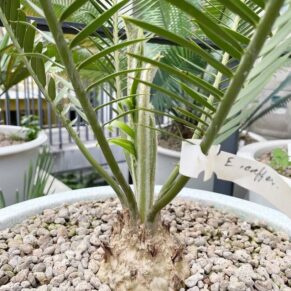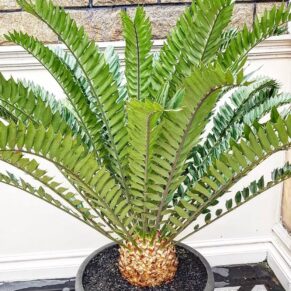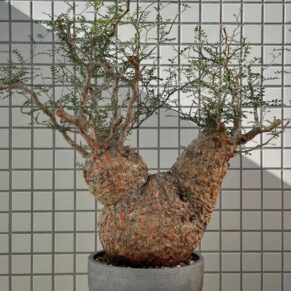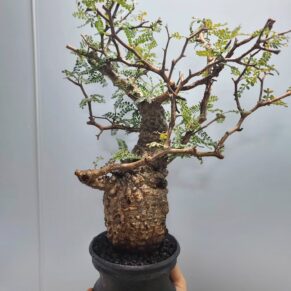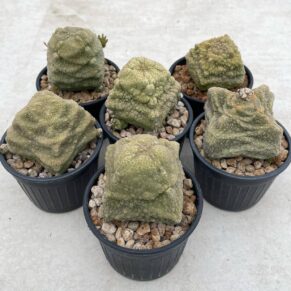- Your cart is empty
- Continue shopping
Shop
Dorstenia gypsophila
$255.00
Discover Dorstenia gypsophila, a rare Somali succulent prized for its caudex form, unique flowers, and drought resilience—perfect for collectors and arid gardens.
Availability:9 in stock
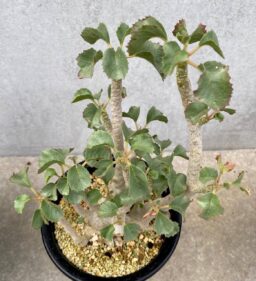
Dorstenia gypsophila: A Comprehensive Guide
Introduction
Dorstenia gypsophila, a member of the Moraceae family, is a rare and captivating succulent native to the arid regions of northern Somalia. This species is renowned for its unique caudiciform growth habit, characterized by a swollen, tuberous stem that stores water, enabling it to survive in its native dry shrubland biome. Fb Group/The plant’s distinctive appearance and resilience make it a prized specimen among succulent enthusiasts and collectors.Shop here:caudexplants.com
Taxonomy and Nomenclature
First described by botanist Lavranos in 1972, Dorstenia gypsophila is classified as follows:
-
Kingdom: Plantae
-
Phylum: Streptophyta
-
Class: Equisetopsida
-
Order: Rosales
-
Family: Moraceae
-
Genus: Dorstenia
-
Species: D. gypsophila:.Shop here:caudexshop
The species epithet “gypsophila” is derived from the Greek words “gypsos” (gypsum) and “philos” (loving), referring to its preference for gypsum-rich soils in its natural habitat. This plant is commonly known as the “Gypsum Dorstenia” due to its association with gypsum-rich environments.Shop here:caudexshop
Morphological Characteristics
Dorstenia gypsophila exhibits several distinctive morphological features:
-
Caudex: The plant develops a swollen, tuberous stem that can reach up to 15 cm in height and 4 cm in diameter. This caudex serves as a water reservoir, allowing the plant to endure prolonged periods of drought.
-
Branches: From the caudex, multiple irregularly arranged branches emerge. These branches are thinner than the main stem and bear leaves clustered near their tips..Shop here:caudexshop
-
Leaves: The leaves are alternate, ovate to cordate (heart-shaped), with coarsely crenate (scalloped) margins. They are dark green and succulent, turning red and papery when dry.dorstenia.n
-
Flowers: D. gypsophila is a monoecious species, meaning it has both male and female flowers on the same plant. The flowers are small, brown, and grouped in flat inflorescences called hypanthodia, which appear at the apex of the branches in the fall.
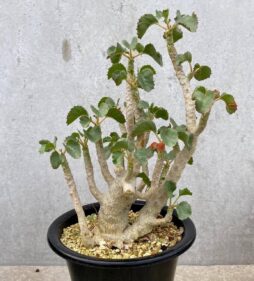
Dorstenia gypsophilia
Habitat and Distribution
This species is endemic to northern Somalia, specifically in the Las Anod region. It thrives in dry shrubland biomes at altitudes around 700 meters. The plant is adapted to survive in arid conditions, often growing on gypsum hills where the soil is poor in nutrients but rich in minerals.
Cultivation and Care
Growing Dorstenia gypsophila requires attention to its specific environmental needs:
-
Light: Provide full sun to partial shade. The plant thrives in bright conditions but should be protected from intense midday sun, which can scorch its leaves.
-
Temperature: Maintain temperatures between 20°C and 30°C (68°F to 86°F). The plant is not frost-tolerant and should be kept in a warm environment.
-
Soil: Use a well-draining, slightly acidic to neutral soil mix with a pH between 6.0 and 7.0. A cactus or succulent mix amended with sand or perlite is suitable.
-
Watering: Water sparingly, allowing the soil to dry out completely between waterings. Overwatering can lead to root rot, a common issue with succulents.
-
Fertilization: Fertilize during the growing season with a low-nitrogen, balanced fertilizer to promote healthy growth.
-
Dormancy: During the winter months, the plant may enter a dormant phase. Reduce watering during this period to mimic its natural environment.
Propagation
Dorstenia gypsophila can be propagated through seeds, stem cuttings, or leaf cuttings:
-
Seeds: Sow seeds in a well-draining soil mix and keep them warm and moist until germination. The plant is self-fertile, and seeds are expelled explosively from the mature seed heads, often populating areas several feet away from the parent plant.
-
Stem Cuttings: Select a healthy, non-flowering stem and allow it to callous for a few days before planting it in a well-draining soil mix.
-
Leaf Cuttings: Remove a healthy leaf and let it callous before planting it in a well-draining soil mix.
Propagation is best done during the plant’s active growing season in spring or early summer.
Conservation Status
Dorstenia gypsophila is classified as “threatened” due to its limited distribution and specialized habitat requirements. Conservation efforts are essential to protect this unique species from habitat destruction and overcollection.

Conclusion
Dorstenia gypsophila is a fascinating and resilient succulent that offers both aesthetic appeal and ecological interest. Its unique morphology and adaptability to arid environments make it a valuable addition to any collection. With proper care and attention, this remarkable plant can thrive and continue to captivate enthusiasts around the world.
Note: While Dorstenia gypsophila is a hardy plant, it is essential to ensure that it is cultivated responsibly to prevent overcollection and to support conservation efforts.

